My Last Blog Post…Because Blogs Are Dead
A lot has changed in online marketing since I began this blog nearly seven years ago. Nobody is questioning the power of social media any more. Nor do they think it’s a fad. Facebook is a global phenomenon. We’ve learned to communicate in 144 characters or less. Foursquare was a fad and is fading.
There came a point in 2012 that I became convinced it wasn’t worth it for a new business to create their own blog. It’s just too hard to create content, promote it and develop an audience from scratch when Facebook has a built in audience and it is so much easier to share. Established blogs could keep creating for a while I thought.
Four years later, I don’t believe the same thing. It’s time for this blog to move to Facebook to its revamped native publishing system called Facebook Notes. So I’m moving over there to publish the latest online marketing articles. Some people may think I’m jumping the gun. Blogs aren’t dead! What about ads? What about my existing content?
Facebook didn’t kill blogs. Mobile devices did. Cell phone ownership is nearing 90% adoption reports Pew research. 68% are smart phones. Personal computer usage is actually starting to decline. Facebook has invested a lot of money and time into making a brilliant mobile platform and now it’s making improvements so no one will ever leave.
Consider the publishing enhancements that came out last year. For big media publishers Facebook users can view 3rd party content in Facebook without ever leaving the platform. It used to be if you opened a piece of shared content on your mobile device, it may or may not load properly. With content being Facebook optimized, that problem is gone. Look at Slate’s Facebook content as an example of this.
Let’s take a look at Notes. What began as a way to publish long Facebook posts has turned into a full blown blogging platform. Users can upload photos, embed videos, add links…all the things you can do on a blog. But it’s in Facebook and so easy to create and so easy to share. But what about search engines? Notes get indexed. Here’s an example of a test I did for my real estate site –
And the tweet I made about the note was also ranked on the first page.
What about affiliate income or selling ads? Make ad posts on your Facebook business page with your affiliate links embedded. Embed ads within your notes. Existing content is still valuable. When I was running SERP tests on Notes, I received a new pingback from a site linking to this blog. It made me reconsider what I was doing for about half a second. Notes also has metrics showing how many people have seen a post as well as how many people opened the Note to read it. In terms of functionality, it doesn’t lack a thing.
We’ve reached a point where findability is being surpassed by shareability. Mobile usage is making it more important to develop content on a standardized platform and Facebook is trying its best to become that platform. So I’m going to jump to that platform right now.
I’ll keep this blog around because it does still get found and it ranks well for certain keywords. There’s still a lot of great content here that I hope to update and repackage as a book some day. For now, there won’t be any new updates over here. But there will be plenty of great content over on Facebook and Twitter.
See you there!
5 WordPress Plugins You Must Have
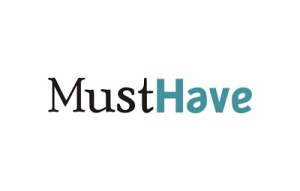 In the last article I discussed the necessity of having a SEO plugin for a WordPress site or blog. Here are five more I recommend, plus a cool option if you have a lot of traffic.
In the last article I discussed the necessity of having a SEO plugin for a WordPress site or blog. Here are five more I recommend, plus a cool option if you have a lot of traffic.
1. Auto tweet new posts – Don’t spend additional time writing tweets. Do it automatically with the WP to Twitter plugin. It even allows custom tweets while you’re writing a post.
2. Make it easy to share – Frictionless sharing is growth hacking. Shareaholic makes it easy to share and you can see your stats at a glance.
3. Post your tweets on your WordPress page – This is great for SEO and adding value for your readers if you don’t have frequent article updates. Really Simple Twitter Feed Widget is exactly what it says it is.
4. Create landing pages and thank you pages on WordPress – The basic version of WordPress creates menu items for every page you add. You don’t want that if you’re trying to create thank you pages for form submissions or custom landing pages. This plugin gives you the option of adding pages or posts to menus – Exclude Pages from Navigation.
5. Google Analytics – See your site stats at a glance in your WordPress dashboard with Google Analytics Dashboard for WP. It automatically adds the tracking code to all your pages and posts with just your GA account number.
If you’re running ads on your site, you’ll like this bonus plugin.
6. Ad management – Maximizing ad revenue is a matter of testing locations. Advertising Manager allows you to custom place ads on your site with no additional coding. It works with all the popular ad networks and allows inline ads on posts.
These six plugins help your site get ranked, grow traffic and increase revenue. If you don’t have them, you’re missing out.
Do I Need a SEO Plugin?
Blogs and content framework software like WordPress are by nature SEO friendly. Each post has its own title which becomes the title tag. The keyword tag in the meta section of the head area of the code isn’t very important any more. If your opening paragraph is keyword rich and aimed for a human reader, your description will be pretty good as well. (If there is no description tag used, search spiders index the first bit of page text they find.) So do you need to go to the trouble of adding a SEO plugin for your WordPress site?
The short answer is yes. There are a few reasons for this. First of all, the plugin will remind you to think of SEO when you’re writing. Not every writer does that and a little reminder can go a long way.
Secondly, a SEO plugin can give a writer greater flexibility and creativity with their articles. For the best SEO results, a writer will need to repeat their optimized keyword phrase as early in the first paragraph as they can. That’s limiting. I didn’t do it in this article, but I can remedy that later by optimizing my description tag.
Let’s take a look real quick at an example:
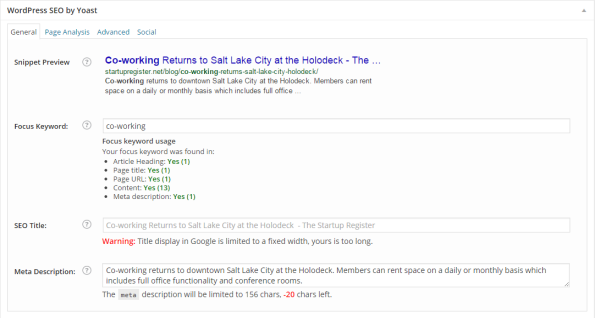 This was an article I wrote last week on another site. I wanted to optimize for the keywords “co-working salt lake city.” But I didn’t begin the article with those words. I wanted to put a more creative spin on it. In the screen shot you can see a field for “meta description.” That’s the language that shows up in the search engines.
This was an article I wrote last week on another site. I wanted to optimize for the keywords “co-working salt lake city.” But I didn’t begin the article with those words. I wanted to put a more creative spin on it. In the screen shot you can see a field for “meta description.” That’s the language that shows up in the search engines.
The SEO plugin also provides statistics and allows alternate titles to be used for publishing on social media sites. I don’t think it matters which SEO plugin you choose so long as it has a custom description tag.
WordPress.com doesn’t use plugins, so how do you create a custom description tag there?
A feature called “excerpts” creates the description tag. If you like your first paragraph, leaving the excerpt tag blank will force the spiders to display the first text they come to. I don’t like to leave things like that to chance, so worst case I’ll quickly cut and paste my first paragraph as the excerpt.
I believe SEO plugins are so important, they’re usually the first type I install. In the next article for WordPress week, I’ll discuss some other useful plugins that are “must haves” for any WordPress site.
How to Choose a WordPress Plugin or Theme
For small businesses wanting a website, WordPress is a cheap and easy to set up choice. With an open development language, it inspires themes and plugins that will do just about anything and look great straight out of the box. Please be aware this article is referencing the self-hosted WordPress, not WordPress.com. Unfortunately, this can create lots of problems too. Since there is no standard to adhere to, anyone can upload a theme or plugin and sometimes they don’t work. Or they don’t work like you imagine they will.
For this reason I don’t like to play around with WordPress very much. I can do a lot of coding, but I don’t do it enough for it not to be frustrating every time I try. This past week, I did get the chance and I discovered a pretty good way to find themes and plugins that work the first time.
I’ve been working on an idea for over a year. WordPress is great for startups to put together a workable prototype without having to sink a lot of funds into development. So I chose WordPress as my platform. I still don’t have a product. There are a lot of reasons for that, the biggest one being I didn’t find a workable theme.
Contrast that with another startup idea I had. I began work on it last week, finished a workable prototype last Sunday and am ready for a full launch now. The difference? I found a theme right away that did everything I wanted and was easy to use. I also found a plugin that provided the critical piece of functionality I wanted. Here’s how I did it.
Finding plugins
Do a Google search for what you want the plugin to do. You’ll get names of plugins in your search results. What you want the plugin to do may have a widely accepted industry name you’re unaware of. Now do a search for that product and include “review.” What you’re hoping to get here is an article with a five to ten plugin comparison. (Be careful of affiliate review sites that don’t offer any real value in the comparison.) Read that article and you should come up with two or three that really interest you. Now, go to the WordPress plugin finder and search for those plugins.
You’ll see an option to install or to read more. Click on read more. Take a look at the description on the main page, then look at the FAQ page. If everything looks like what you want, check out the review tab. If it doesn’t get consistently good reviews, don’t install it. You’re welcome. I just saved you hours of torment.
Finding themes
There are a million themes available for WordPress. The screenshots you’ll see for them will show them in their best light. You may have to do custom coding in the CSS to get it to look like the screen shot. Again, I recommend searching for the type of theme you want (two column, three column, responsive) and reading the reviews on them. You’ll get a better idea of what the actual work will be like from previous users when you install it.
I did find a theme editor plug-in, on a review site, that looks like it will solve some of the issues with setting up themes. I haven’t used it, but I will definitely try it on my next project.
Other considerations
Some plugins conflict with some themes, so you may have your theme setup exactly the way you want it, install a plugin, and have the whole thing break. That’s why it’s important to know the names of your theme and plugins. Again, do a search for the issue and some kind soul will probably already have a solution.
Be sure to check the last time the plugin or theme was updated and how well the developer responds to questions. I found the more active the developer is, the better the product is.

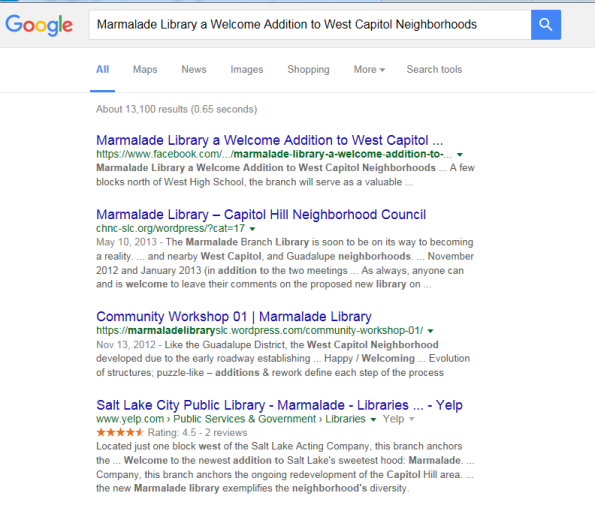
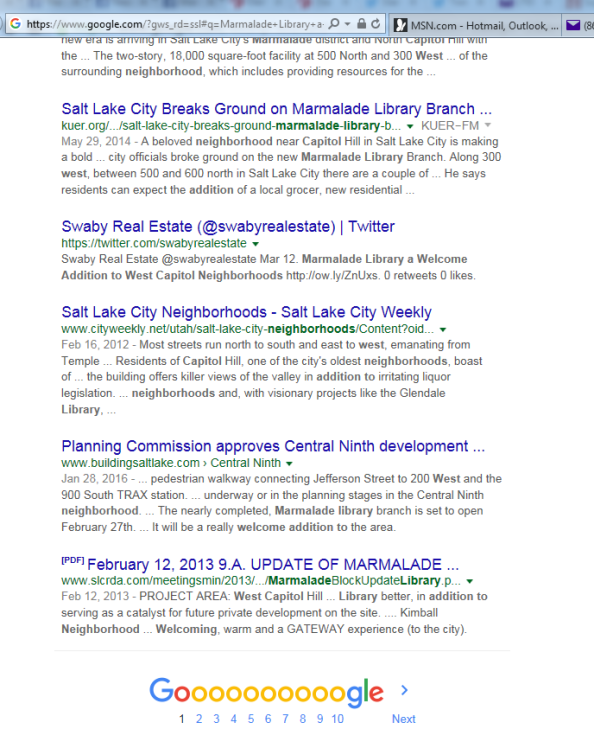

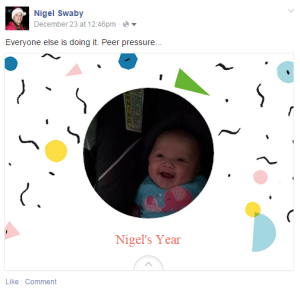






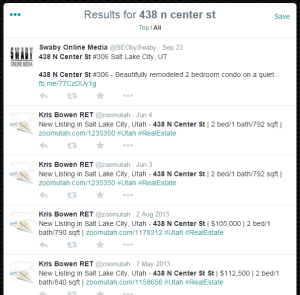
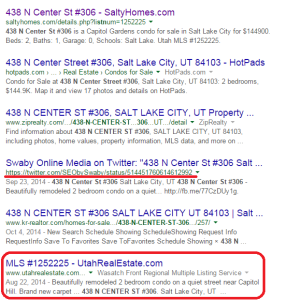

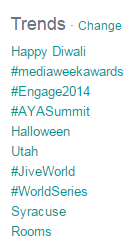
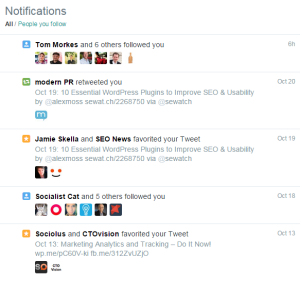
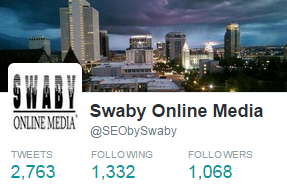






Visitor Comments: